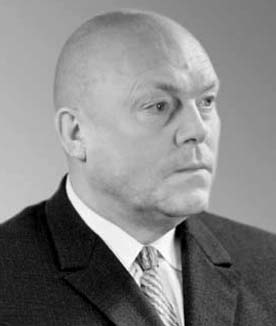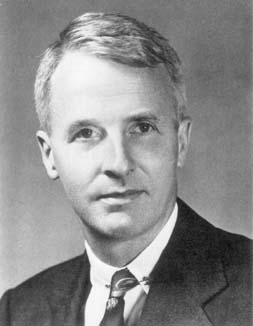<Back to Index>
- Mathematician Anatoly Ivanovich Maltsev, 1909
- Mathematician Garrett Birkhoff, 1911
PAGE SPONSOR

Anatoly Ivanovich Maltsev (Malcev) (Russian: Анато́лий Ива́нович Ма́льцев 27 November N.S./14 November O.S. 1909 - 7 June 1967) was born in Misheronsky, near Moscow, and died in Novosibirsk, USSR. He was a mathematician noted for his work on the decidability of various algebraic groups. Malcev algebras (generalizations of Lie algebras) are named after him.
At school, Maltsev demonstrated an aptitude for mathematics, and when he left school in 1927, he went to Moscow State University to study Mathematics. While he was there, he started teaching in a secondary school in Moscow. After graduating in 1931, he continued his teaching career and in 1932 was appointed as an assistant at the Ivanovo Pedagogical Institute located in Ivanovo, near Moscow.
Whilst teaching at Ivanovo, Maltsev made frequent trips to Moscow to discuss his research with Kolmogorov. Maltsev's first publications were on logic and model theory. Kolmogorov soon invited him to join his graduate program at Moscow University, and, maintaining his post at Ivanovo, Maltsev effectively became Kolmogorov's student.
In 1937, Maltsev published a paper on the embeddability of a ring in a field. Two years later, he published a second paper where he gave necessary and sufficient conditions for a semigroup to be embeddable in a group.
Between 1939 and 1941, he studied for his doctorate at the Steklov Institute of the USSR Academy of Sciences, with a dissertation on the Structure of isomorphic representable infinite algebras and groups.
In 1944, Maltsev became a professor at the Ivanovo Pedagogical Institute where he continued to work on group theory and linear groups in particular. He also studied Lie groups and topological algebras.
In 1958, Maltsev became an Academician of the Soviet Academy of Sciences.
In 1960, Maltsev was appointed to a chair in mathematics at the Mathematics Institute at Novosibirsk and chaired the Algebra and Logic Department of Novosibirsk State University. He founded the Siberian section of the Mathematics Institute of the Academy of Sciences, the Siberian Mathematical Society and the journal "Algebra i Logika". Maltsev also founded the "Algebra and Logic Seminar" attended by his students Igor Lavrov, Larisa Maksimova, Dmitry Smirnov, Mikhail Taitslin, and A. Vinogradov, as well as by Yuri Ershov and others. This seminar, in essence, started a new and extremely fruitful school in model theory and decidability of elementary theories.
During the early 1960s, Maltsev worked on problems of decidability of elementary theories of various algebraic structures. He showed the undecidability of the elementary theory of finite groups, of free nilpotent groups, of free soluble groups and many others. He also proved that the class of locally free algebras has a decidable theory.
Maltsev received many honors, including the Stalin Prize in 1946 and Lenin Prize in 1964.
In 1962 he founded the mathematical journal Algebra i Logika.

Garrett Birkhoff (January 19, 1911, Princeton, New Jersey, USA – November 22, 1996, Water Mill, New York, USA) was an American mathematician. He is best known for his work in lattice theory.
The mathematician George Birkhoff (1884 – 1944) was his father.
The son of the mathematician George David Birkhoff, Garrett began the Harvard University BA course in 1928 after less than seven years of prior formal education. Upon completing his Harvard BA in 1932, he went to Cambridge University in England to study mathematical physics but switched to studying abstract algebra under Philip Hall. While visiting the University of Munich, he met Carathéodory who pointed him towards two important texts, Van der Waerden on abstract algebra and Speiser on group theory.
Birkhoff held no Ph.D., a qualification British higher education did not emphasize at that time, and did not even bother obtaining an M.A. Nevertheless, after being a member of Harvard's Society of Fellows, 1933 – 36, he spent the rest of his career teaching at Harvard. From these facts can be inferred the number and quality of Birkhoff's papers published by his 25th year.
During the 1930s, Birkhoff, along with his Harvard colleagues Marshall Stone and Saunders Mac Lane, substantially advanced American teaching and research in abstract algebra. In 1941 he and Mac Lane published A Survey of Modern Algebra, the second undergraduate textbook in English on the subject (Cyrus Colton MacDuffee's An Introduction to Abstract Algebra was published in 1940). Mac Lane and Birkhoff's Algebra (1967) is a more advanced text on abstract algebra. A number of papers he wrote in the 1930s, culminating in his monograph, Lattice Theory (1940; the third edition remains in print), turned lattice theory into a major branch of abstract algebra. His 1935 paper, "On the Structure of Abstract Algebras" founded a new branch of mathematics, universal algebra. Birkhoff's approach to this development of universal algebra and lattice theory acknowledged prior ideas of Charles Sanders Peirce, Ernst Schröder and Alfred North Whitehead; in fact, Whitehead had written a 1898 monograph entitled Universal Algebra.
During and after World War II, Birkhoff's interests gravitated towards what he called "engineering" mathematics. During the war, he worked on radar aiming and ballistics, including the bazooka. In the development of weapons, mathematical questions arose, some of which had not yet been addressed by the literature on fluid dynamics. Birkhoff's research was presented in his texts on fluid dynamics, Hydrodynamics (1950) and Jets, Wakes and Cavities (1957).
Birkhoff, a friend of John von Neumann, took a close interest in the rise of the electronic computer. Birkhoff supervised the Ph.D. thesis of David M. Young on the numerical solution of the partial differential equation of Poisson, in which Young proposed the successive over - relaxation (SOR) method. Birkhoff then worked with Richard S. Varga, a former student, who was employed at Bettis Atomic Power Laboratory of the Westinghouse Electronic Corporation in Pittsburgh and was helping to design nuclear reactors. Extending the results of Young, the Birkhoff - Varga collaboration led to many publications on positive operators and iterative methods for p-cylic matrices.
Birkhoff's research and consulting work (notably for General Motors) developed computational methods besides numerical linear algebra, notably the representation of smooth curves via cubic splines.
Birkhoff published more than 200 papers and supervised more than 50 Ph.D.s. He was a member of the National Academy of Sciences and the American Academy of Arts and Sciences.